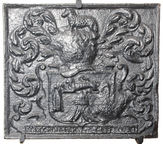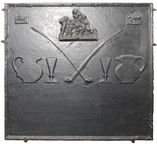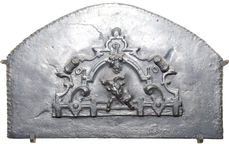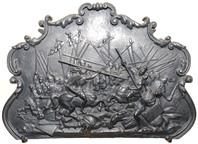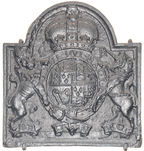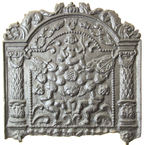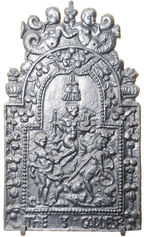-
546
Description: Rectangular; ovolo edging; shield, helm, crest, mantling and motto of the Merchant Taylors’ Company: Argent a Pavilion Imperial Purple garnished Or lined Ermine between two Mantles also Imperial Purple lined Ermine on a chief Azure a Lion passant guardant Or.
Notes: Arms were re-granted to the Company in 1586; the excrescences on the helm and shield are probably the result of splashes caused when pouring the iron into the mould from too great a height. Mitford collection, Petworth House.
Inscription: CONCORDIA PARVAE RES CRESCUNT [In Harmony Small Things Grow]
Arms: Worshipful Company of Merchant Taylors
- Decoration tags:
- rectangular (shape)
- ovolo (edging)
- whole carved pattern
- armorial
- text
Manufactured: in the late-16th to early-17th century possibly in the Weald area of England.
Current location: Petworth House, Petworth, West Sussex, England.
Museum number: NT/PET/M/101 (part of the National Trust museum group)
- Attached to series:
- Livery company firebacks
-
548
Description: Arched rectangular central panel with bead edging; female figure, a crown above her head, holding two snakes; arched rectangular border with fillet edging; top centre, knot of ribbon with festoons of pomegranates suspended therefrom via a ring on each shoulder of the plate; at the bottom, two crossed palm fronds; on top, symmetrical arrangements of swirled foliage; on each side, a plain rectangular panel with fillet edging.
Notes: Possibly the allegorical figure of Democracy; the form of the palm fronds and the swirled foliage on top suggest a common pattern-maker with the TAN series and the Mayfield 'Dutch' series. Mitford collection, Petworth House.
- Decoration tags:
- 'Dutch' (shape)
- fillet (edging)
- whole carved pattern
- extension panels
- pictorial
- allegorical
- humans
Manufactured: in the early-18th century in England.
Current location: Petworth House, Petworth, West Sussex, England.
Museum number: NT/PET/M/102 (part of the National Trust museum group)
- Attached to series:
- British 'Dutch' style firebacks
- TAN series
-
551
Description: Rectangular; ovolo-moulded edging; top centre, stamp formed of a carved domestic scene of a family around a table, between two small mirrored rectangular stamps each of a cow; lower centre, symmetrical arrangement of two jugs, two goblets and two crossed churchwarden pipes, all in low relief.
Notes: The domestic group has been formed from a decorative iron mantelpiece ornament portraying the tale of the goose that laid golden eggs. Having killed the goose, the family are lamenting the loss of their bounty (see Ames, 1980, p.94). The style of the fireback suggests a pastiche using designs suggesting the past. The same mantelpiece group can be seen as decoration on the kitchen spit assemblage at Petworth House, West Sussex, which was cast at Robert Chorley's foundry at Cocking, south of Midhurst. Evidently this and another fireback bearing the same ornament stamp were among items from the Cowdray estate sold in 1898. Mitford collection, Petworth House.
- Decoration tags:
- rectangular (shape)
- ovolo (edging)
- carved stamps
- animals
- humans
- objects
Manufactured: in the early-19th century probably at Cocking Foundry in the Weald area of England.
Current location: Petworth House, Petworth, West Sussex, England.
Museum number: NT/PET/M/43 (part of the National Trust museum group)
Citation: Ames, A., 1980, Collecting Cast Iron (Ashbourne, Moorland Publishing).
- Attached to series:
- Cocking foundry firebacks
- Ornament stamp firebacks
- Metalware stamp firebacks
-
558
Description: Arched rectangular shape; fillet edging; top centre, stamp formed of a carved domestic scene of a family around a table; in top corners, repeated small stamp of St George and the Dragon; below, repeated stamp of a pineapple in a pot; centre; small stamp of the royal arms of the United Kingdom 1801-37.
Notes: The domestic group has been formed from a decorative iron mantelpiece ornament portraying the tale of the goose that laid golden eggs. Having killed the goose, the family are lamenting the loss of their bounty (see Ames, 1980, p.94). The same mantelpiece group and pineapple stamp can be seen as decoration on the kitchen spit assemblage at Petworth House, West Sussex, which was cast at Robert Chorley's foundry at Cocking, south of Midhurst. Evidently this and another fireback bearing the same ornament stamp were among items from the Cowdray estate sold in 1898. Mitford collection, Petworth House.
Arms: Royal arms of the United Kingdom 1801-37
- Decoration tags:
- rectangular with round arch (shape)
- fillet (edging)
- carved stamps
- armorial
- royal
- animals
- humans
- plants
Manufactured: in the early-19th century probably at Cocking Foundry in the Weald area of England.
Current location: Petworth House, Petworth, West Sussex, England.
Museum number: NT/PET/M/50 (part of the National Trust museum group)
Citation: Ames, A., 1980, Collecting Cast Iron (Ashbourne, Moorland Publishing).
- Attached to series:
- Cocking foundry firebacks
- Ornament stamp firebacks
- Metalware stamp firebacks
-
559
Description: Arched rectangle with crude scalloping around the edges; elaborate, symmetrical strapwork frame with scrolls top left and right, and below, a bunch of grapes hanging from the top, and the head and forelegs of a goat climbing through; inside each upper scroll, a small astragel edged oval.
Notes: This strap-work stamp, characteristic of late-16th and early-17th century architectural drawings and engravings and derivative of the work of artists like Hans Vredeman de Vries, was probably derived from interior carving on a fireplace overmantel or similar. The goat and bunch of grapes suggest an allusion to Bacchus. Marks round the edge of this fireback suggest that it may have been reduced from a larger size. Mitford collection, Petworth House.
- Decoration tags:
- rounded arched (shape)
- scalloped (edging)
- simple stamps
- architectural
- animals
- plants
- objects
Manufactured: in the late-16th to early-17th century possibly in the Weald area of England.
Current location: Petworth House, Petworth, West Sussex, England.
Museum number: NT/PET/M/53 (part of the National Trust museum group)
- Attached to series:
- Miscellaneous stamp firebacks
-
560
Description: Quasi-arched rectangular shape with symmetrical double fillet rococo edging; high relief pictorial battle scene with mounted knights carrying lances and pennants.
Notes: The battle scene may have been inspired by more than one classical portayal of a battle in history; likely sources are 'The Defeat of the Pisans at the Tower of St Vicenzo' by Giorgio Vasari and 'Alexander the Great's crossing of the Granicus' by Charles Le Brun. An engraving by Daniel Kellerthaler (1574-1648) has a similar frame enclosing an unidentified cavalry conflict. Mitford collection, Petworth House.
Copies of this fireback are known.
- Decoration tags:
- baroque (shape)
- complex individual (edging)
- whole carved pattern
- pictorial
- humans
Manufactured: in the late-18th to early-19th century in England.
Current location: Petworth House, Petworth, West Sussex, England.
Museum number: NT/PET/M/54 (part of the National Trust museum group)
- Attached to series:
- Miscellaneous pattern firebacks
-
563
Description: Arched rectangular shape; cavetto edging; Stuart royal arms of England (quarterly, 1st and 4th, France and England, 2nd Scotland and 3rd Ireland) with garter, crown, motto and supporters; initials either side of crown base.
Notes: As in others of this series the design overlaps the edging. Mitford collection, Petworth House.
Copies of this fireback are known.
Inscription: C R / ...SOIT QVI MAL Y ...
Arms: English Stuart royal
- Decoration tags:
- rectangular with round arch (shape)
- cavetto (edging)
- whole carved pattern
- armorial
- royal
- text
Manufactured: in the mid- to late-17th century in the Weald area of England.
Current location: Petworth House, Petworth, West Sussex, England.
Museum number: NT/PET/M/57 (part of the National Trust museum group)
- Attached to series:
- Small cavetto series
- Stuart royal armorial firebacks
-
575
Description: Arched rectangular shape; cavetto-moulded edging; on each side a column of small overlapping leaves above a pedestal with a single acanthus leaf; issuing from the top of each column two ribbons, in figure-of-eight with grenade terminals, fly across the arch; within an arched rectangular central panel with bead edging three naked children disport about a swag of fruit, with a central pomegranate, suspended from the top of each column; one figure sits on the top, facing right, the other two hang symmetrically from below, with mirrored swirls behind them; along the base is a line of acanthus leaves; on top a sea serpent is curled on each end.
Notes: The design may have been inspired by the paintings of Jan Pauwel Gillemans the younger (1651-1704); he may have worked in London in 1675-8. Another version of the fireback (no. 591), probably by the same pattern-maker, has a slightly different design. Mitford collection, Petworth House.
Copies of this fireback are known.
- Decoration tags:
- 'Dutch' (shape)
- cavetto (edging)
- whole carved pattern
- planklines
- pictorial
- mythological
- humans
- plants
Manufactured: in the late-17th century in England.
Current location: Petworth House, Petworth, West Sussex, England.
Museum number: PET/M/66 (part of the National Trust museum group)
- Attached to series:
- Carolean 'Dutch' series
-
520
Description: Arched rectangular central panel with bead edging; with tassel at top; three nude female figures: on top, Juno/Hera with a peacock, to the left Venus/Aphrodite, the young cupid/Eros at her feet, to the right Minerva/Athena with spear and shield; arched rectangular border with fillet edging; the heads of two putti and from them two suspended festoons of fruit and leaves; at the bottom, the inscription, THE 3 GODDESES, widely spaced. On top, two figures of Triton blowing seashells. On each shoulder of the fireback, a fluted vase with flowers issuing.
Notes: The three eponymous goddesses are those whose beauty was the subject of the Judgement of Paris. The composition is copied from an engraving by Adriaen Collaert (c1560-1618). This fireback is an instance of a continental back which has been recast in England, the opportunity being taken to insert an English inscription in place of the customary date and pattern maker's monogram. Mitford collection, Petworth House.
Copies of this fireback are known.
Inscription: THE 3 GODDESES [sic]
- Decoration tags:
- 'Dutch' (shape)
- fillet (edging)
- whole carved pattern
- planklines
- pictorial
- mythological
- text
Manufactured: in the late-17th century in England.
Current location: Petworth House, Petworth, West Sussex, England.
Museum number: NT/PET/M/74 (part of the National Trust museum group)
- Attached to series:
- 'Dutch' NDW series
- Judgement of Paris firebacks
-
521
Description: Rectangular with arched, mirrored scrolls on top and central scallop shell; fillet edging; Pan, with a goat behind, trees to left and right; a putto above right; at the bottom, a separate rectangular panel with mirrored scrolled foliage.
Notes: A scene apparently unrelated to a specific classical narrative, and without the customary decorated border. Mitford collection, Petworth House.
Copies of this fireback are known.
- Decoration tags:
- rectangular with ornate arch (shape)
- fillet (edging)
- whole carved pattern
- pictorial
- mythological
- animals
- humans
- plants
Manufactured: in the early-18th century in England.
Current location: Petworth House, Petworth, West Sussex, England.
Museum number: NT/PET/M/75 (part of the National Trust museum group)
- Attached to series:
- Late pictorial series (all)
- Late pictorial series 2
